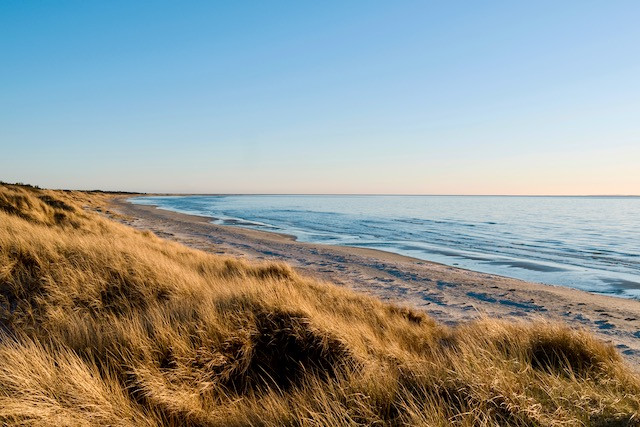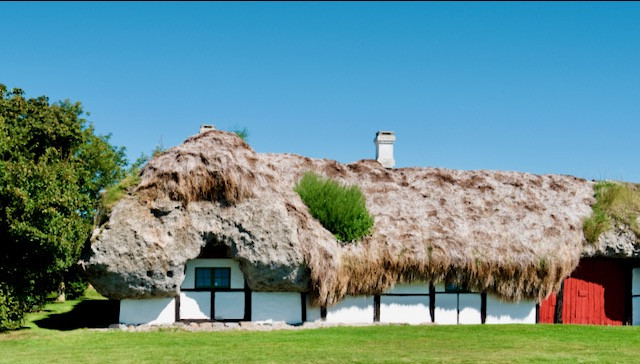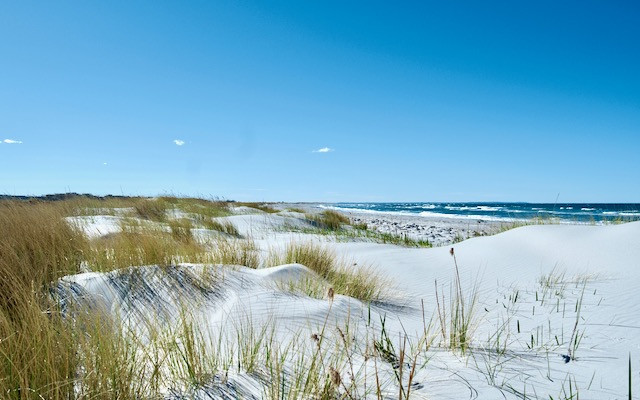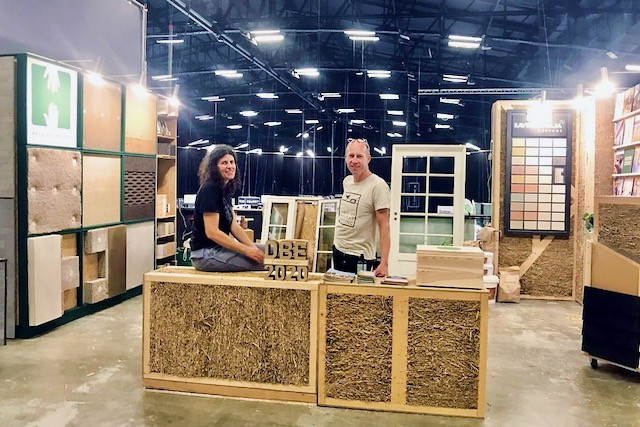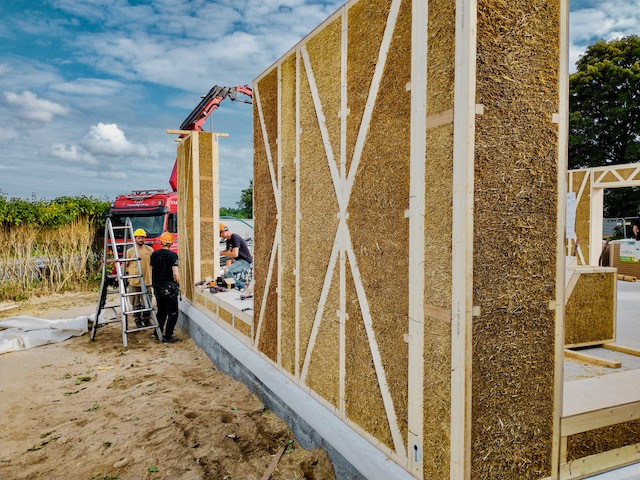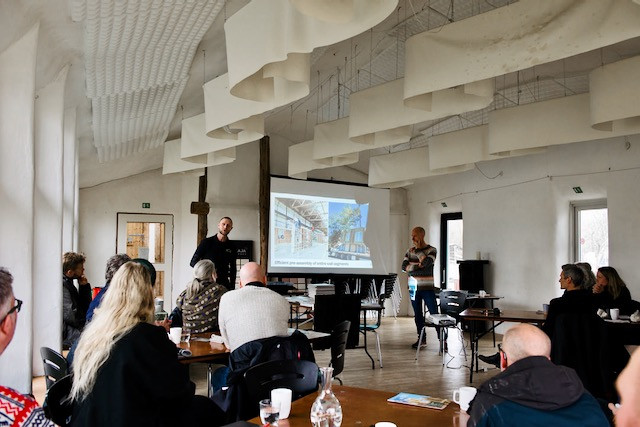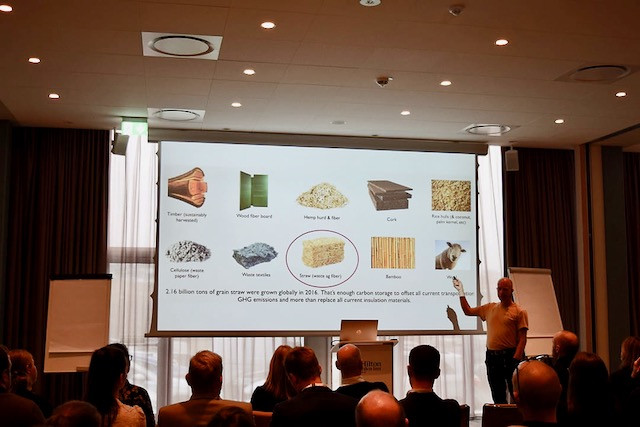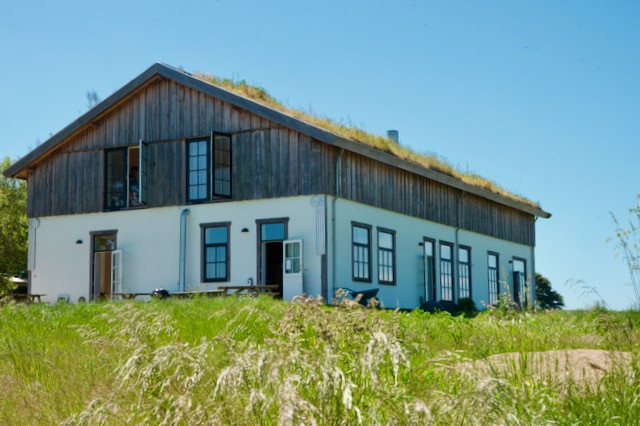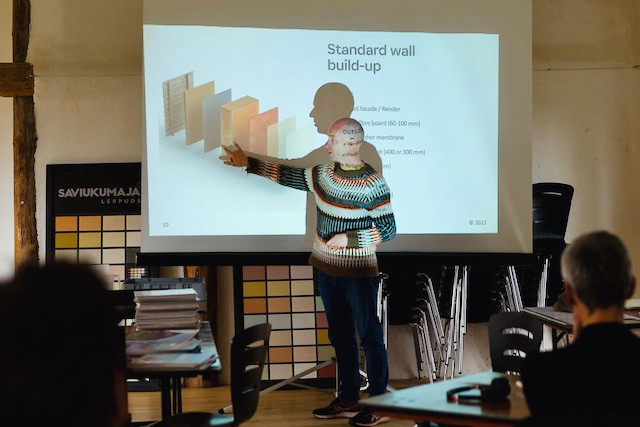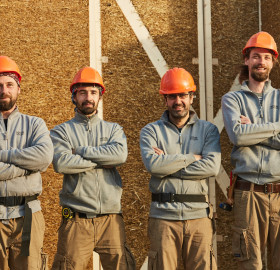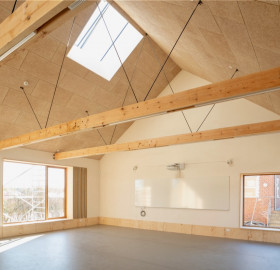Lars Keller is co-founder of EcoCocon Denmark. He lives with his wife and business partner, Jo Morandin, and their two kids in the ecovillage community of Friland. Their house is made from straw bales, clay plaster and lots of rejuvenated building materials.
Lars is a passionate earth lover and a huge advocate of carbon-storing technologies. In our interview, he took us on a journey from a small island with centuries-old seaweed buildings to commercial production of a leading innovation in the sector.
Drawing on his 20 years of experience working with natural materials, Lars reveals how the construction industry can turn from a climate crook into a climate hero.
You have dedicated your life and career to preserving our planet. What sparked your interest in sustainable construction?
Growing up on the sunny island of Læsø, the northernmost Danish island, I discovered an important potential, which forms the foundation of my work today.
I was but a child, but I clearly remember the eelgrass roofs. They were a relic of the past. No new ones had been made in anyone's living memory. Having such a roof often meant you would have a tarpaulin or metal roof plates on top of it to keep the rain out.
But - and this is the important bit - some eelgrass roofs were still in good condition despite being hundreds of years old!
To understand how crazy that is, having well-functioning, centuries-old eelgrass roofs, you have to keep in mind that Læsø during the 16th and 17th century witnessed a devastating man-made ecosystem breakdown. It was the result of a vast production of salt, a process by which seawater was distilled to get the white gold of the Middle Ages. To fuel the production, the forests and heather fields were completely destroyed until there was nothing left but sand.
Today, Læsø is a lush island, but for centuries it was barren and windswept, almost a sandbank, with such harsh living conditions it’s hard to imagine.
The largest village on Læsø - Hals - became unlivable due to shifting sand. By 1720, the last family abandoned the village. New farms were built in less sandy places. Bricks were taken from Hals’ church and farms, timber was obtained from shipwrecks, clay was dug from the soil and eelgrass was gleaned from the beaches for roofing material.
The fact that some eelgrass roofs, developed at that time, are still in such good condition demonstrates the incredible potential of bio-based building materials.
For many years you were helping to nurse a grassroot straw-bale construction movement. You used to live in a truly minimalist way, in a home of no more than 9 m2, leaving as little ecological footprint as possible. At what point did you decide you need to take your social impact to the next level?
The natural building movement that I got immersed in during the late 90’s was a fantastic environment to come of age in. It was based on an open-source approach, an interest in the common good and a lush amount of caring, curiosity, friendship and just loads of energy. It was a fantastic mix.
By the end of the ‘00s, the toolbox for straw-bale builders was well equipped. Networks were established, printed books were available, youtube videos started to appear, physical workshops flourished, official testing programmes were not so rare anymore, and professional builders emerged.
It seemed to me that those who wanted to build their own healthy, sustainable and affordable home were a lot better off than ten years prior. The next logical development was to go prefab and commercial, which required skills and ambitions I didn’t possess. So I retired.
What changed in your outlook?
In 2014, my friend and natural builder-colleague, Paul Lynch, told me about a Lithuanian company called EcoCocon. Supposedly, they had come up with a solution that managed to present straw, wood and clay in a way that made conventional craftsmen and wanna-be home owners interested and curious.
I went to the Building Green fair in Copenhagen in late 2014 and met with Marius Tarvydas and Domantas Surkys. By observing visitors at the stand and carefully listening to their questions, I was convinced that EcoCocon had indeed managed to bridge the gap between grassroot and commercial. We became partners.
I spent the next year getting to know the building system and the organisation behind it. After that, Jo and I decided that this was our chance to scale up, and thus contribute to the agenda Greta Thunberg in those years made so abundantly clear was urgent. We kept going, and here we are now.
In your view, what are the biggest opportunities bio-based building materials offer?
They give us the ability to move away from construction materials that emit CO2, towards construction materials that store CO2. I am talking about the growth and production phase. This has the potential of transforming the construction sector from a climate crook into a climate hero. The potential is enormous.
The agriculture sector can become a supplier of raw materials for the construction sector.
We are dealing with an area that is ready to be scaled up now. Bio-based building materials are old friends, and the last 40 years have seen an acceleration of the refinement of products and solutions.
There will, of course, be improvements and new developments, as with all other products, but now is the time to press the Go-button.
What bio-based materials do you consider essential?
We are starting to experience what will be an era of multiple and simultaneous system breakdowns, each one causing unimaginable and dire consequences. Unfortunately, there are no easy solutions or quick fixes.
Our first step is coming to terms with the fact that our Earth is a limited, closed and intricately interconnected web of systems. Our next step is to accept the consequences, including the limitations.
In regard to the building sector, the conclusion is as simple as it is unnerving and disrupting. We must stop using materials if they are not regenerative, renewable or reused. A technical way to express this is that from now on, we must only use materials that sequester CO2 emissions in phase A1-3 of the Life Cycle Assessment-framework. In short, buildings must be grown by the sun.
Understanding this and acting correspondingly increases the robustness of the systems we inhabit, reduces their vulnerabilities and is a very wise investment on behalf of our grandchildren.
To answer the question about what bio-based materials I consider essential, my answer is that it is not enough to just use bio-based materials. We have to also consider land management, water usage, biodiversity, chemical pollution and more. Using readily available farming by-products is, to my understanding, a very good choice for the bulk of buildings. That is, in essence, what the EcoCocon panel is: straw for the bulk of the volume, intelligent and sparse use of wood for the rest.
You are an avid sustainability advocate. What are the factors you consider vital in pushing this agenda forward?
Passion, persistence, cooperation.
Magic happens when others listen and join in, be that local municipality, organisations or companies.
We all depend on each other, whether you’re tall or short, big or skinny, a fisherman or a mayor. If we let go of petty differences like title or status and refuse to see others as potential opponents, we will realise how much we have in common, how much we need one another, and how much we can accomplish together.
What do you see as the biggest challenges related to the use of bio-based materials in construction?
Lack of knowledge.
Among customers, craftsmen, construction markets, contractors, engineers, architects, politicians, test institutes and technical schools. The list goes on. The good news is there’s a lot happening right now.
Then there’s money and power that cannot be held to account. In the long run, I am very confident of bio-based materials. It’s the urgency that worries me.
We see the ongoing climate emergency and cannot afford to be patient. We need to accelerate things, scale up and invest. There are major challenges in the legislation we need to sort out quickly. It’s not the people who stand in the way of this, nor is it the young generation.
If you could choose one thing that could bring quick progress, what would it be?
Introducing an appropriate carbon tax.
A carbon tax would allow the market mechanisms to automatically step in and complement the huge efforts of the public sector and civil society.
What projects do you find exciting when it comes to bio-based building materials?
Basically all projects that use materials which are good for the indoor environment while having a positive effect on the climate crisis.
In Denmark there are EcoCocon projects such as the Nordic Folkecenter's Tiny House in Thy, Feldballe Friskole on Djursland, the School for Life on Møn, and owner-builders.
There is Havnens Hænder - supplying bio-based building materials; Kalk - focusing on Cradle to Cradle lime-products; Burnt Wood - upgrading waste wood into facade cladding; CINARK - teaching based on the CINARK Manifesto; Logik & Co - building sustainably in the city; SBi, the national fire test institute - forging a legal pathway...
There is loose fill insulation of wood and paper, batts of hemp, flax, eelgrass, sheep wool, paper, wood. There are wooden roofs, thatched roofs, seaweed roofs….
You took part in a recent debate on bio-based materials called ‘What does it take for us to move forward?’ How would you sum it up?
Before we take action, we need insight. We need to educate. We need decision makers to understand that the solutions are already here: the materials can already be purchased, researchers have thoroughly examined them, architects are using them, and customers want them. Finally we need the legislators to implement the carbon -tax.
This interview is an adapted version of an article by Building Green, a Denmark-based community of professionals with interest in sustainable construction.
LARS KELLER
Lars Keller is co-founder of EcoCocon Denmark and a passionate earth lover. He’s been working with bio-based materials and sustainable construction for over 20 years. Lars is actively helping the industry become part of the climate solution. In his own words, collaboration, long-term thinking and brave decisions are some of the most important components we will all need in the coming years.
Cover photo by Ken Hermann

